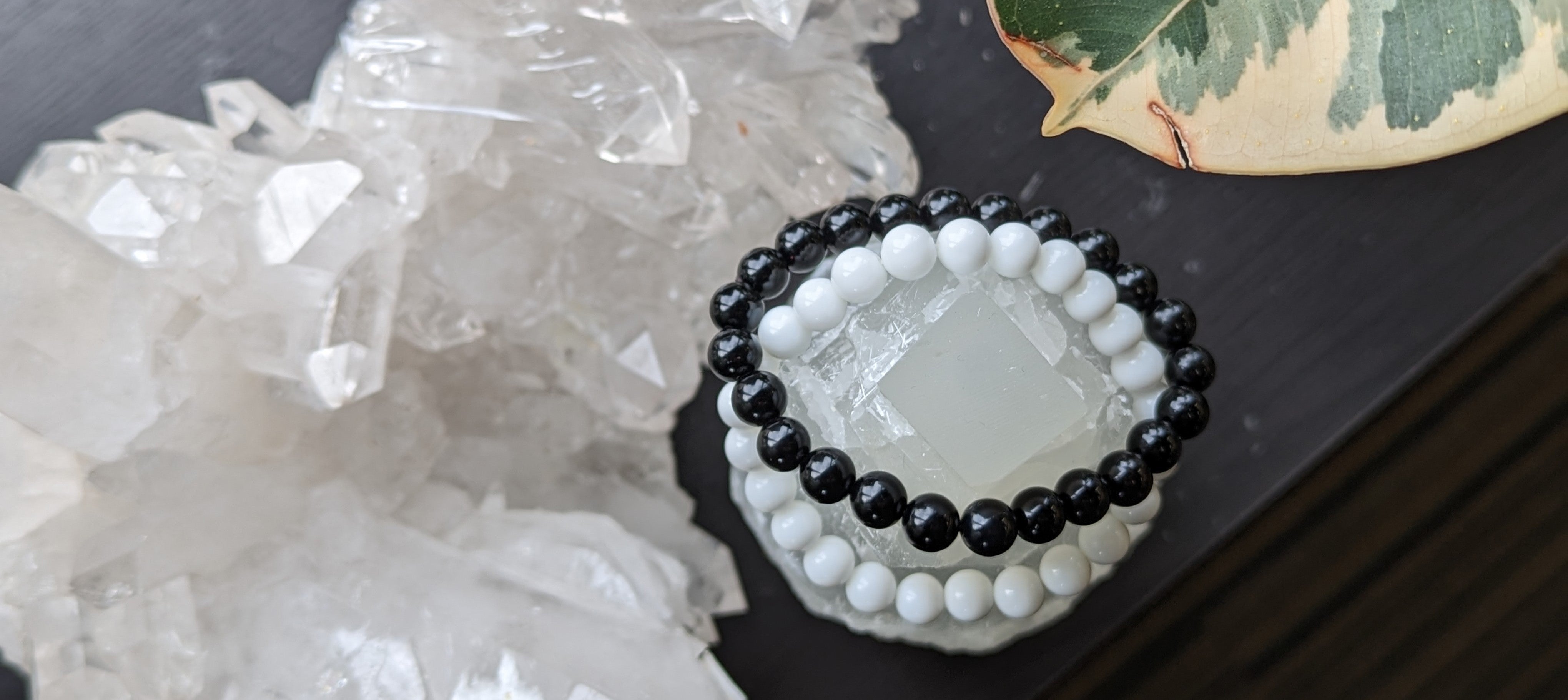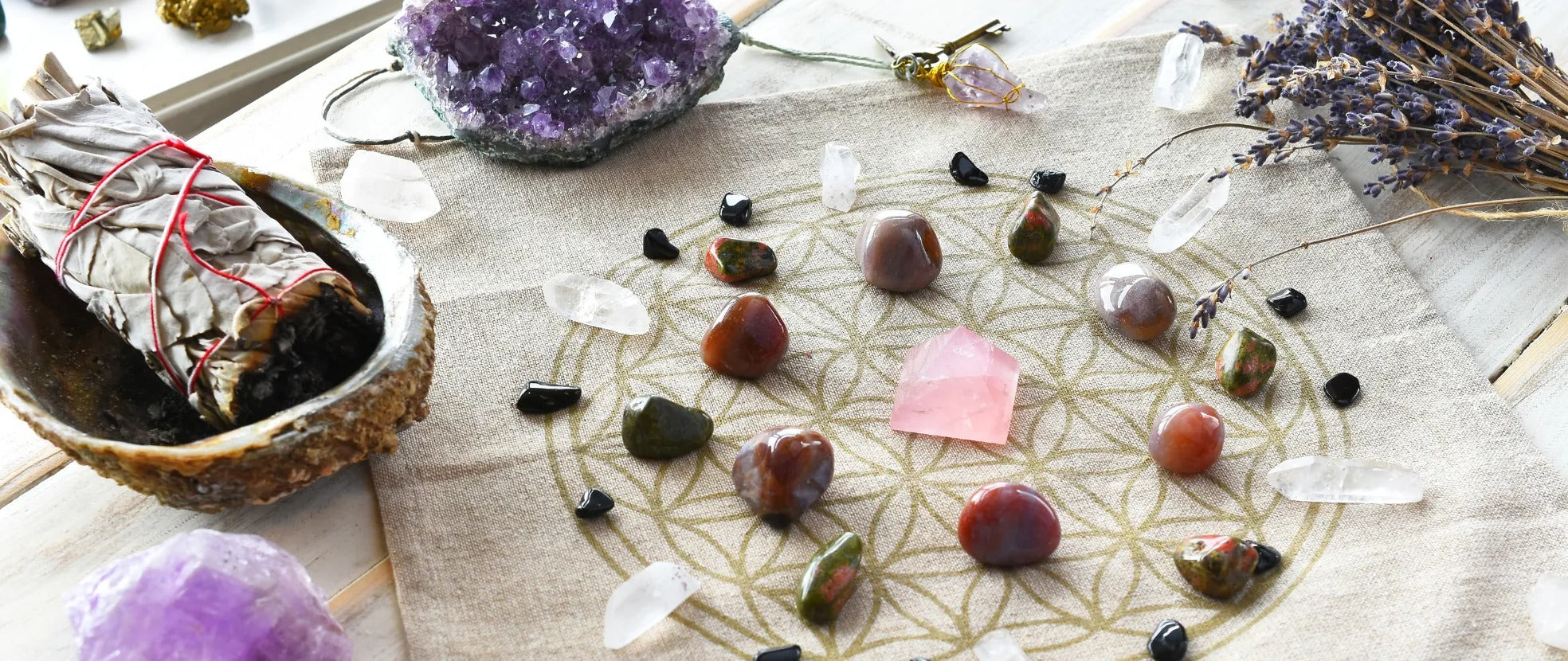Not all crystals come straight from the Earth—and that is okay. Some are refined, enhanced, or crafted in labs. Knowing which is which helps you explain origin and treatment confidently, build trust, and stock the right blends for margin and repeat sales.
Quick links: Citrine (heat-treated), Opalite, Goldstone, Aura Quartz, Wholesale program.
Synthetic vs. Enhanced Gemstones: Quick Definitions
What is the difference between a gemstone born in nature and one crafted in a lab? You might be surprised how similar they are—and how both carry unique energies. From dazzling man-made creations to enhanced natural stones, these treasures hold beauty, durability, and great stories. This guide keeps definitions clear so you can disclose with confidence.
| Type | What It Means | Examples |
|---|---|---|
| Natural | Mined; minimal alteration (cut/polish) | Quartz, Amethyst, Agate (undyed) |
| Enhanced (treated) | Natural stone modified after mining to alter color, clarity, or durability | Citrine (heat-treated Amethyst), Blue Topaz (irradiated + heated), Dyed Agate/Chalcedony, Stabilized Turquoise, Metal-bonded Aura Quartz, Heated Red Tiger’s Eye |
| Man-made (synthetic) | Created in a lab or furnace; may match natural chemistry/optics or be glass-based | Opalite (glass), Goldstone (copper-infused glass), Bismuth crystals, Carborundum, Moissanite, Cubic Zirconia, Lab Sapphire/Spinel/Emerald, Slag/Green Glass |
Why Stories Sell: A Retail Perspective
Man-made and enhanced stones are eye-catching. Customers often assume they are natural because the color is vivid or the finish is mesmerizing. Explaining how they are made turns confusion into curiosity. When you tell the story—how Bismuth grows into hopper crystals, how Aura Quartz bonds precious metal onto natural Quartz, how Opalite glows, or how Slag Glass comes from glassmaking byproducts—customers lean in and buy with confidence. Honest stories convert.
Skimmable Catalog (A–Z): Man-Made & Enhanced Stones
Man-Made (Synthetic / Glass-Based) — A–Z
-
 Bismuth Crystals (lab-grown metal): Stepped “hopper” shapes form as molten bismuth cools. Iridescent colors are from thin-film oxidation on the surface. Edges can be fragile. Sells on story and spectacle.
Bismuth Crystals (lab-grown metal): Stepped “hopper” shapes form as molten bismuth cools. Iridescent colors are from thin-film oxidation on the surface. Edges can be fragile. Sells on story and spectacle.
-
 Blue Goldstone (“Blue Sandstone”): A cobalt-toned version of Goldstone with fine glitter. Extremely consistent. Great for bracelets and palms.
Blue Goldstone (“Blue Sandstone”): A cobalt-toned version of Goldstone with fine glitter. Extremely consistent. Great for bracelets and palms.
-
 Carborundum (Silicon Carbide): Electric-furnace product with intense rainbow-metallic surface. Jagged crystal habit. Label clearly as man-made.
Carborundum (Silicon Carbide): Electric-furnace product with intense rainbow-metallic surface. Jagged crystal habit. Label clearly as man-made.
-
 Cubic Zirconia (CZ): Diamond simulant grown from zirconium dioxide at high temperature. High dispersion and clarity. Common in calibrated jewelry sizes.
Cubic Zirconia (CZ): Diamond simulant grown from zirconium dioxide at high temperature. High dispersion and clarity. Common in calibrated jewelry sizes.
-
 Fiber-Optic “Cat’s Eye” Glass: Drawn glass with parallel fibers that create a moving chatoyancy line. Ultra-consistent beads and cabochons.
Fiber-Optic “Cat’s Eye” Glass: Drawn glass with parallel fibers that create a moving chatoyancy line. Ultra-consistent beads and cabochons.
-
 Glass “Obsidian” (Black/Blue/Green): Fully man-made glass sold as obsidian. Look for rounded gas bubbles, mold seams, and uniform color. Use for décor and carvings.
Glass “Obsidian” (Black/Blue/Green): Fully man-made glass sold as obsidian. Look for rounded gas bubbles, mold seams, and uniform color. Use for décor and carvings.
-
 Goldstone (Copper-Infused Glass): Copper crystals suspended in glass create a glitter field. Brown/red and green variants exist. Durable and eye-catching.
Goldstone (Copper-Infused Glass): Copper crystals suspended in glass create a glitter field. Brown/red and green variants exist. Durable and eye-catching.
-
 Green Glass (“Bottle Glass” / Cast Glass): Recycled or cast glass polished into stones. Expect bubbles and flow lines. Great for color walls; label as glass.
Green Glass (“Bottle Glass” / Cast Glass): Recycled or cast glass polished into stones. Expect bubbles and flow lines. Great for color walls; label as glass.
-
 Hemalyke / Magnetic “Hematite”: A man-made magnetic ferrite pressed into beads and shapes. Much stronger magnetism than natural hematite. Highly uniform metallic luster.
Hemalyke / Magnetic “Hematite”: A man-made magnetic ferrite pressed into beads and shapes. Much stronger magnetism than natural hematite. Highly uniform metallic luster.
-
 Lab-Created Moissanite (SiC): Brilliant, durable diamond alternative (most moissanite in market is lab-grown). High fire and hardness; popular in jewelry.
Lab-Created Moissanite (SiC): Brilliant, durable diamond alternative (most moissanite in market is lab-grown). High fire and hardness; popular in jewelry.
-
 Lab Opal (Synthetic Opal): Polymer-impregnated silica spheres arranged to mimic play-of-color. Regular, “pixel-like” color patches are a tell.
Lab Opal (Synthetic Opal): Polymer-impregnated silica spheres arranged to mimic play-of-color. Regular, “pixel-like” color patches are a tell.
-
 Lab Sapphire / Ruby (Synthetic Corundum): Verneuil, Czochralski, or flux-grown crystal boules cut into calibrated stones. Vivid, very clean, affordable.
Lab Sapphire / Ruby (Synthetic Corundum): Verneuil, Czochralski, or flux-grown crystal boules cut into calibrated stones. Vivid, very clean, affordable.
-
 Lab Spinel: Flame-fusion or flux-grown; intense color and high clarity. Common in vintage and modern jewelry lines.
Lab Spinel: Flame-fusion or flux-grown; intense color and high clarity. Common in vintage and modern jewelry lines.
-
 Opalite (Glass-Based): Translucent with a soft blue glow and orange edge-flash. Typically flawless. Excellent entry price point for gifts. Shop Opalite.
Opalite (Glass-Based): Translucent with a soft blue glow and orange edge-flash. Typically flawless. Excellent entry price point for gifts. Shop Opalite.
-
 Slag Glass (Industrial Byproduct): Glass and metalmaking byproduct that cools into rocky masses, often blue/green. Great for landscape décor, large bowls, or garden pieces.
Slag Glass (Industrial Byproduct): Glass and metalmaking byproduct that cools into rocky masses, often blue/green. Great for landscape décor, large bowls, or garden pieces.
-
 “Strawberry Quartz” (Glass Imitations): Many ultra-clear pieces with red sparkles are glass. Giveaways: bubbles, perfect transparency, uniform glitter. Natural strawberry quartz is rarer and shows mineral inclusions rather than glitter.
“Strawberry Quartz” (Glass Imitations): Many ultra-clear pieces with red sparkles are glass. Giveaways: bubbles, perfect transparency, uniform glitter. Natural strawberry quartz is rarer and shows mineral inclusions rather than glitter.
Enhanced (Natural, Then Treated) — A–Z
-
 Agate / Chalcedony (Dyed): Bright pinks, blues, and greens are commonly dyed. Look for color pooling in pores and along bands.
Agate / Chalcedony (Dyed): Bright pinks, blues, and greens are commonly dyed. Look for color pooling in pores and along bands.
-
 Amethyst (Heat-Modified & Resin-Filled): Heating can lighten purple or produce green prasiolite. Some spheres and polished pieces are resin-filled to stabilize pits post-polish. Disclose when known.
Amethyst (Heat-Modified & Resin-Filled): Heating can lighten purple or produce green prasiolite. Some spheres and polished pieces are resin-filled to stabilize pits post-polish. Disclose when known.
-
 Aura Quartz (Metal-Bonded Quartz): Natural quartz heated in a vacuum while exposed to metal vapor. Aqua Aura bonds gold (blue). Angel Aura uses platinum/silver (soft rainbow). Titanium Aura uses titanium (bold rainbow). Finish is permanent under normal wear.
Aura Quartz (Metal-Bonded Quartz): Natural quartz heated in a vacuum while exposed to metal vapor. Aqua Aura bonds gold (blue). Angel Aura uses platinum/silver (soft rainbow). Titanium Aura uses titanium (bold rainbow). Finish is permanent under normal wear.
-
 Blue Topaz (Irradiated + Heated): Produced colors include Swiss and London blue. Stable color. Always disclose irradiation.
Blue Topaz (Irradiated + Heated): Produced colors include Swiss and London blue. Stable color. Always disclose irradiation.
-
 Chalcopyrite “Peacock Ore” (Heated): Heating intensifies blue, purple, and red tarnish. Vivid rainbow pieces are typically heat-treated.
Chalcopyrite “Peacock Ore” (Heated): Heating intensifies blue, purple, and red tarnish. Vivid rainbow pieces are typically heat-treated.
-
 Citrine (Heat-Treated Amethyst): Natural amethyst heated to change iron states, shifting purple to golden yellow/orange. Common and consistent. Disclose as heat-treated.
Citrine (Heat-Treated Amethyst): Natural amethyst heated to change iron states, shifting purple to golden yellow/orange. Common and consistent. Disclose as heat-treated.
-
 Howlite (Dyed): Naturally white and porous; takes dye evenly into “turquoise” blue and other colors. Popular for beads.
Howlite (Dyed): Naturally white and porous; takes dye evenly into “turquoise” blue and other colors. Popular for beads.
-
 Jadeite / Nephrite (Dyed / Bleached & Polymer-Impregnated “B-Jade”): Uniform vivid greens often indicate dye. “B-Jade” is bleached and polymer-filled for clarity. Disclose treatment type when known.
Jadeite / Nephrite (Dyed / Bleached & Polymer-Impregnated “B-Jade”): Uniform vivid greens often indicate dye. “B-Jade” is bleached and polymer-filled for clarity. Disclose treatment type when known.
-
 Lapis Lazuli (Dyed): Dye deepens blue and masks calcite. Check pores and vein edges for color concentration.
Lapis Lazuli (Dyed): Dye deepens blue and masks calcite. Check pores and vein edges for color concentration.
-
 Moonstone (Heated): Gentle heating can refine adularescence and clarity. Avoid harsh cleaning on embellished pieces.
Moonstone (Heated): Gentle heating can refine adularescence and clarity. Avoid harsh cleaning on embellished pieces.
-
 Opal Doublets / Triplets (Assembled): Slices of natural opal layered with backing and cap to protect and intensify color. Durable and affordable; disclose as assembled.
Opal Doublets / Triplets (Assembled): Slices of natural opal layered with backing and cap to protect and intensify color. Durable and affordable; disclose as assembled.
-
 Quartz “Crackle” (Thermal Shock): Clear quartz heated then quenched to create internal fracturing that shimmers. Often dyed afterward to highlight the network.
Quartz “Crackle” (Thermal Shock): Clear quartz heated then quenched to create internal fracturing that shimmers. Often dyed afterward to highlight the network.
-
 Quartz (Dyed): Vivid purples, blues, and greens in massive quartz are usually dye. Inspect fractures and pores.
Quartz (Dyed): Vivid purples, blues, and greens in massive quartz are usually dye. Inspect fractures and pores.
-
 Quartz (Smoky by Irradiation): Some smoky quartz on the market is irradiated for deeper color. Disclose if known.
Quartz (Smoky by Irradiation): Some smoky quartz on the market is irradiated for deeper color. Disclose if known.
-
 Tiger’s Eye Family: Classic golden tiger’s eye is natural. Red tiger’s eye is commonly heat-treated for deeper red-brown. Blue “Hawk’s Eye” can be natural or dyed; verify color origin and disclose.
Tiger’s Eye Family: Classic golden tiger’s eye is natural. Red tiger’s eye is commonly heat-treated for deeper red-brown. Blue “Hawk’s Eye” can be natural or dyed; verify color origin and disclose.
-
 Turquoise (Stabilized / Reconstituted): Natural turquoise can be porous and brittle. Stabilization with resin improves hardness and polish for jewelry. “Reconstituted” material is powdered turquoise with resin—budget-friendly but should be labeled as such.
Turquoise (Stabilized / Reconstituted): Natural turquoise can be porous and brittle. Stabilization with resin improves hardness and polish for jewelry. “Reconstituted” material is powdered turquoise with resin—budget-friendly but should be labeled as such.

Treatments Explained: Metal Bonding vs. Coating (And More)
- Metal Bonding (e.g., Aqua Aura): Natural quartz is heated in a vacuum chamber and exposed to metal vapor (gold for Aqua Aura). Metal atoms bond to the surface, creating a durable and permanent color layer with an even, iridescent sheen.
- Metal Coating (e.g., Titanium Aura / Rainbow Amethyst): Physical vapor deposition of titanium or other metals produces a thin, uniform film with rainbow effects. Permanent under normal wear; avoid abrasives.
- Heat Treatment: Controlled heating changes color centers or oxidation states (amethyst to citrine; red tiger’s eye). Properly done, color is stable.
- Irradiation + Heat: Used for stones like blue topaz and some smoky quartz to create or deepen color, then annealed to stabilize.
- Dyeing: Porous stones absorb dye (agate, chalcedony, howlite). Look for color concentration in cracks and pores.
- Stabilization / Resin Filling: Porous or pitted stones (turquoise; some amethyst spheres) are impregnated or surface-filled with resins to improve durability and finish after polishing.
How to Explain It to Customers (Scripts That Build Trust)
- Enhanced vs. Man-Made in one line: “This piece is natural but treated for color,” or “This one is crafted in a lab for a consistent look.”
- Heat-Treated Citrine: “It began as amethyst; gentle heat transformed the iron content into these warm golden tones.” (Shop Citrine)
- Opalite: “It is a glass-based stone loved for its serene glow—great budget-friendly gift with a dreamy look.” (Shop Opalite)
- Aura Quartz: “Clear quartz is bonded with precious metal vapor for that permanent iridescent finish.” (Shop Aura Quartz)
- Goldstone: “Copper crystals suspended in glass create the sparkle—popular for intention gifts around ambition.” (Shop Goldstone)
- Turquoise (Stabilized): “Natural turquoise can be soft; stabilization helps it hold a polish and last in jewelry. We disclose that so you know what you are getting.”
- “Strawberry Quartz” (Glass Imitations): “Some are glass with red inclusions. If you prefer natural strawberry quartz, ask us to show examples with mineral inclusions rather than glitter.”

10 Ways to Identify Man-Made or Enhanced Stones
- Overly vibrant colors: Neon pinks or blues point to dye.
- Color pooling: Dye collects in pores and along banding (agate, chalcedony, howlite).
- Perfect clarity with bubbles: Gas bubbles inside are classic glass tells (opalite; glass “strawberry quartz”).
- Flawless uniformity: Stones that look “too perfect” with no inclusions can be synthetic or glass-based.
- Even iridescent film: Uniform rainbow sheen suggests metal bonding/coating (aura quartz types).
- Flash in fractures: Rainbow flashes in fracture-filled items suggest resins or oils.
- Unnatural combinations: Electric red or blue tiger’s eye is usually treated; disclose accordingly.
- Highly uniform color: Irradiated blue topaz and dyed lines show even color versus natural zoning.
- Flow lines or mold seams: Glass often shows flow patterns or seams; fractures are conchoidal.
- Weight/temperature feel: Glass tends to feel lighter for size and warms faster in hand than dense crystalline minerals.
Stock Transparent, Story-Ready Assortments
• Shop Citrine (heat-treated)
• Add Opalite & Goldstone
• Feature Aura Quartz for visual pop
• Explore Wholesale program
FAQs
Are synthetic (lab-grown) and enhanced stones accepted in the trade?
Yes. Both are widely accepted. The key is clear disclosure so buyers know origin and treatment.
Do treated or man-made crystals still have energy for customers who care?
Yes, absolutely. Man-made crystals still form crystalline structures and carry their own frequencies. Whether natural or man-made, crystals can be used for energy and intention work when that is important to the customer.
How can I quickly spot dyed or coated stones?
Look for overly vibrant colors, pooled dye in pores or banding, bubbles inside glass, or a uniform iridescent film. Compare to known natural color ranges.
What should I disclose on product cards?
State origin and treatment in one clear line: “Natural Amethyst, heat-treated to Citrine,” “Glass-based man-made Opalite,” or “Natural Quartz with gold vapor bonding (Aqua Aura).”
Which items convert best for gift shoppers?
Opalite hearts and pendants, Goldstone bracelets, Aura-coated points, and heat-treated Citrine small points. These offer bright color, consistency, and friendly price points.
Any care tips for enhanced stones?
Avoid harsh chemicals or ultrasonic cleaners on dyed, coated, stabilized, or resin-filled items. Use mild soap, water, and a soft cloth.
Sources
The Editors of Encyclopaedia Britannica. (n.d.). Verneuil Process. Britannica. Accessed at https://www.britannica.com/topic/Verneuil-process
Elwell, D. (1989). Crystal Growth in Science and Technology. Springer Link. Accessed at https://link.springer.com/book/10.1007/978-1-4613-0549-1
Czochralski Process (n.d.). PVA TePla. Accessed at https://www.pvatepla-cgs.com/en/technologies/czochralski-process-cz





